Mascot, 12 Chapters, 1931. Starring George Brent, Frankie Darro, Georgia Hale, Theodore Lorch, Lafe McKee, Pat O’Malley, Frank Brownlee, Dick Dickinson, Frank Lanning, Bob Kortman, and Rin Tin Tin as Rinty.
The citizens of the prosperous frontier mining town Sainte Suzanne are warned–by drum and arrow message–that they will be wiped out by Indians unless they flee. These threats are backed up by Indian raids; one victim of said raids is a gold-mine owner named Carter, although his young son Jimmy escapes the attack. Jimmy joins forces with Alan Scott, the brother of an undercover army officer who was murdered while investigating the Indian trouble–and with the dead officer’s dog, a highly intelligent canine named Rinty. The three heroes, along with the Sheriff’s foster daughter Dianne, set out to discover the identity of the Wolf Man, the cloaked and mysterious white man behind the Indian threat to the town. Is prominent businessman Hayden the guilty party? Or is it Lafarge, Dianne’s real father and a fugitive with a grudge against Hayden? Then there’s an Indian settler named George, the Carter mine foreman MacDonald, and the Sheriff–could one of them be the Wolf Man? Scott’s dead brother, unbeknownst to Scott, has hidden a note that gives the Wolf Man’s identity in Rinty’s collar, but that note is later tampered with and will cause our heroes more confusion as they pursue their quest to save Sainte Suzanne.
Lightning Warrior, filled with amazing action and energetic performances, moves at a thrilling pace and serves as a good final film for its top-billed star Rin-Tin-Tin, who had been one of the biggest draws in Hollywood during the silent era. While exceedingly enjoyable, however, Warrior has a plot that makes virtually no sense, in the grand Mascot serial tradition. The riddle of the Wolf Man’s identity gives added interest to the standard settlers vs. Indians plot, but it also entails a climactic “explanation” that blithely contradicts countless earlier scenes. Writers Ford Beebe, Wyndham Gittens, and Colbert Clark were obviously not John Dickson Carr, but they could have come up with a mystery a little less nonsensical than this.
Plot holes (more like plot craters) aside, Lightning Warrior is a thrilling cliffhanger, with some incredible action sequences overseen by directors Ben Kline and Armand Schaefer. However, the guiding spirit of the action scenes is Yakima Canutt, whose excellent stunt work (abetted by Kermit Maynard, Cliff Lyons, Bob Reeves, and various canine doubles for Rinty) really makes the fights and chases sparkle. Among the action highlights are Frankie Darro and Rinty’s battle with the Wolf Man in a mining cable car, George Brent and Darro’s attempt to escape the Indians by climbing across a gorge on a rope, and Brent’s rescue of Darro from a runaway wagon (this scene allows Canutt to perform his trademark “fall under the team of horses” stunt). An unarmed Brent’s acrobatic defeat of three Indians with nothing more than a rope and a tree limb is also a highlight, as are Rinty’s various battles with henchmen (in one of which the amazing dog manages to knock two thugs off a cliff single-pawed).
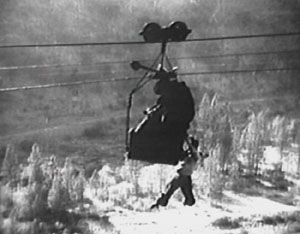
Above: Rinty fights the Wolf Man while Frankie Darro hangs on for dear life in the cable-car sequence.
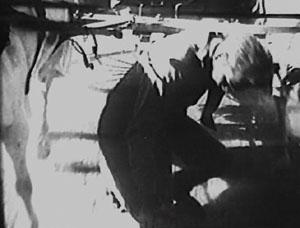
Above: Yakima Canutt, doubling George Brent, clambers about among a team of running horses.
The film’s locations–the canyons, pine forests, and rolling hills of Kernville, the ramshackle buildings and dark tunnels of the gold mine, and eerie Bronson Cave– provide excellent visual backdrops for the action. The cliffhanger sequences are memorable and inventive, some of the standouts being Brent’s apparent crushing by a horse-propelled grist mill after a fierce fight with Theodore Lorch, Brent plunging from a cliff in a mine car while Darro is about to be squashed by mining machinery, and Darro and Rinty trapped in a cave by flaming Indian arrows.
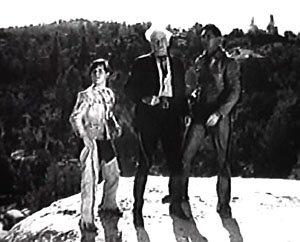
Above: Frankie Darro, Lafe McKee, and George Brent pause in front of an impressive scenic backdrop (at Kernville).
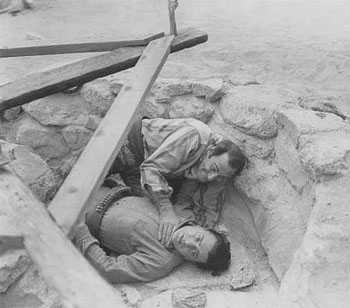
Above: Theodore Lorch and George Brent grapple in the grist mill.
Frankie Darro handles pathos (when mourning his father’s death) and spunk (when tackling the Wolf Man and his followers single-handed) equally well, and serves as an excellent juvenile lead. George Brent, later a major leading man at Warner Brothers, does a fine job as the mature hero, delivering his lines in a smooth and dignified manner but also conveying genuine toughness and determination. The third hero, Rin-Tin-Tin, definitely lives up his fame as the greatest canine star in Hollywood history; the dog responds to danger with reactions that look for all the world like studied “double-takes,” and uncannily seems to vary his expressions to suit different situations.

Above: Rinty discovers that Frankie Darro is imperiled on a cliff ledge.
The entire cast is good, but Brent, Darro, and Rinty deliver the most natural performances of the lot; most of the other players occupy varying places on the theatricality scale. Georgia Hale is a pretty heroine, but her grim, rather vehement vocal delivery seems to indicate she’s not entirely comfortable with sound technology. Pat O’Malley, as her sheriff foster-father, affects an exaggerated Western drawl that can be rather distracting at times, particularly when he keeps pronouncing “Indians” as “In-deens.” Kindly-looking Lafe McKee does a good job playing against type as the scowling, self-important Hayden, a role more suited to Robert Frazer or Hooper Atchley.
Theodore Lorch is delightfully hammy as McKee’s enemy Lafarge; his cartoonish French accent comes and goes, but he mugs, snarls, leers, and raves at a consistent level of energy throughout the serial. Frank Brownlee, as the feisty mine foreman MacDonald, chews the scenery himself in several scenes, particularly when admonishing the settlers to stay and fight for their town. Frank Lanning, as Indian George, doesn’t have as much screen time as the other suspects, and is allowed no memorable scenes to match those of McKee, Lorch, and Brownlee.

Above: A grinning and maniacal Theodore Lorch confronts an understandably nervous Lafe McKee.
Dick Dickinson is good as the Wolf Man’s principal henchman, while Bob Kortman has relatively little to do as the secondary henchman. Interestingly, their characters maintain a facade of honesty for much of the serial, making Lightning Warrior perhaps the only cliffhanger in which the “action heavies” get a chance to imitate the typical “brains heavy’s” righteous pose. The Wolf Man himself disappointingly has a villainous getup that lacks lupine accouterments, but his black cloak still helps him to cut a fairly impressive visual figure; typically, he is not played the actor he eventually turns out to be, though I’m not sure who does perform his scenes. Hayden Stevenson is Darro’s ill- fated father, and silent serial heroine Helen Gibson appears in the pleasingly spooky opening chapter, as a pioneer woman frightened by the ominous Indian drums foretelling the Wolf Man’s campaign of terror. Yakima Canutt appears in multiple roles as luckless townsmen, as do other members of the stunt team.
The Lightning Warrior might not match its Universal serial contemporaries like Heroes of the West when it comes to simple and intelligent plotting, but it puts those other cliffhangers in the shade when it comes to well-executed and lightning-paced action sequences (forgive the obvious word play). Those viewers who have learned to expect and allow for disappointment in Mascot’s final “explanatory” chapters will be enjoy the serial immensely, since at Mascot the real fun is always in the chase after the villain, not his illogical unmasking.
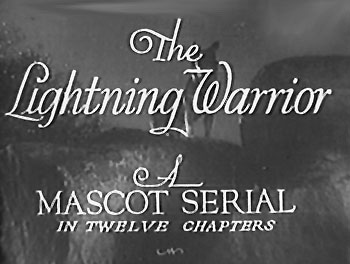
This is another one of Mascot’s greatest serials. Only problem is, almost all prints of this are missing the last few minutes of chapter one. Someone did reconstruct the cliffhanger from the beginning of chapter two.
I liked this one a lot for the reasons you gave, despite the hammy acting from some of the suspects, and the typically convoluted Mascot cheat mystery. One thing about Mascot. The suspects are not just clones sitting around a table. They are individualized so it matters which one turns out to be guilty. And nice to see the original Rinty. **** out of *****
I also find Mascot’s individualized suspects more interesting than the interchangeable committee members used in most of Republic’s serials; in the Mascot outings, the red-herring characters actually get to take part in the action and do something besides serve as a background red herring. My biggest complaint about the majority of the Mascot mystery-villain suspects, of course, is the frequently illogical way in which said suspects behave; Robert Frazer’s suspicious Secret Service agent in The Three Musketeers especially does some things that make no sense in light of the revelation of his eventual innocence.
The only serial I can think of that manages to make the suspects distinctive without making them do anything nonsensical is Columbia’s Mandrake the Magician; there, the characters played by Kenneth MacDonald, Edward Earle, and Don Beddoe are all distinguished from each other and get to engage in the action, simultaneously serving as red herrings but never doing anything that leaves the viewer scratching his head.